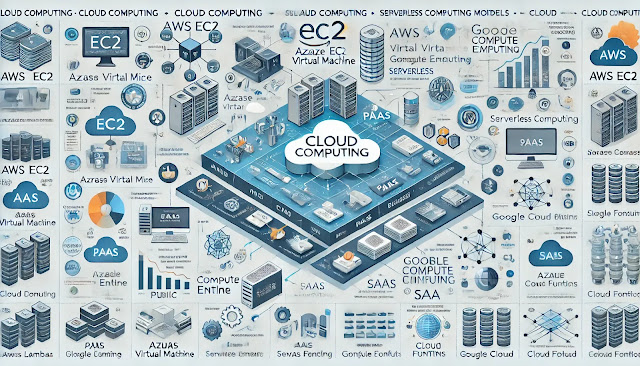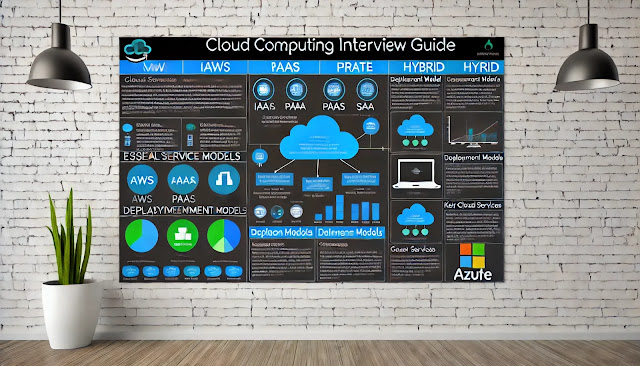1. What is cloud computing?
Cloud computing refers to the delivery of computing services
(e.g., servers, storage, databases, networking, software) over the internet
("the cloud"). It allows businesses to access technology resources
on-demand, with a pay-as-you-go model.
2. What are the main types of cloud deployment models?
- Public
Cloud: Resources are provided over the internet by a third-party cloud
provider (e.g., AWS, Azure).
- Private
Cloud: Cloud infrastructure dedicated to a single organization,
offering more control and security.
- Hybrid
Cloud: Combines public and private clouds, allowing data and
applications to be shared between them.
3. What are the primary cloud service models?
- Infrastructure
as a Service (IaaS): Provides virtualized computing resources over the
internet (e.g., AWS EC2, Azure VM).
- Platform
as a Service (PaaS): Offers a platform allowing customers to develop,
run, and manage applications (e.g., AWS Elastic Beanstalk, Azure App
Services).
- Software
as a Service (SaaS): Delivers software applications over the internet
(e.g., Google Workspace, Office 365).
4. What is AWS EC2?
Amazon EC2 (Elastic Compute Cloud) is a web service that
provides resizable compute capacity in the cloud, enabling users to launch
virtual servers (instances) for various workloads.
5. What is Azure Virtual Machine Scale Sets?
Azure Virtual Machine Scale Sets (VMSS) allow users to
deploy and manage a set of identical, load-balanced VMs that automatically
scale to handle changing workloads.
6. What is Google Compute Engine?
Google Compute Engine (GCE) is Google's IaaS service,
providing virtual machines that run on Google’s infrastructure, supporting
various machine types, configurations, and operating systems.
7. How does AWS Lambda work?
AWS Lambda is a serverless computing service that lets you
run code without provisioning or managing servers. It automatically scales and
executes your code in response to events, such as HTTP requests or file
uploads.
8. What is Azure Functions?
Azure Functions is a serverless compute service that allows
you to run event-driven code without managing infrastructure. Functions can
scale based on demand and integrate with various Azure services.
9. What is Google Cloud Functions?
Google Cloud Functions is a serverless execution environment
that runs code in response to events. You only pay for the time your code
executes, making it a cost-effective solution for event-driven tasks.
10. What is Amazon S3?
Amazon S3 (Simple Storage Service) is an object storage
service that provides scalable storage for any data type. It is designed for
durability, scalability, and security, supporting use cases like backup, big
data analytics, and content distribution.
11. What is Azure Blob Storage?
Azure Blob Storage is Microsoft's object storage solution
optimized for storing large amounts of unstructured data such as text, images,
or videos. Blobs can be accessed via HTTP/HTTPS from anywhere in the world.
12. What is Google Cloud Storage?
Google Cloud Storage is a unified object storage solution
for developers and enterprises, offering near-infinite storage with strong data
consistency. It can be used for data lakes, backups, and serving data directly
to users.
13. What is AWS VPC?
Amazon Virtual Private Cloud (VPC) enables users to
provision a logically isolated section of the AWS cloud, where they can launch
AWS resources within a virtual network. It provides control over IP addressing,
subnets, and routing.
14. What is Azure Virtual Network (VNet)?
Azure Virtual Network (VNet) is a fundamental building block
for private network communication in Azure. It enables many types of Azure
resources to communicate with each other securely.
15. What is Google VPC?
Google Virtual Private Cloud (VPC) allows you to define a
logically isolated network for Google Cloud resources. It provides flexibility
in scaling and managing network configurations and supports global
communication between resources.
16. What is AWS IAM, and why is it important?
AWS Identity and Access Management (IAM) enables you to
securely control access to AWS services and resources. It allows you to define
permissions and manage users, roles, and policies to ensure secure and
restricted access.
17. What is Azure Active Directory?
Azure Active Directory (Azure AD) is Microsoft’s cloud-based
identity and access management service. It provides single sign-on,
multi-factor authentication, and conditional access to protect cloud
applications.
18. What is Google Cloud IAM?
Google Cloud Identity and Access Management (IAM) enables
administrators to manage access to resources by granting granular permissions
to users, groups, and services, ensuring fine-grained control over access.
19. What is AWS CloudFormation?
AWS CloudFormation is an Infrastructure as Code (IaC)
service that allows you to define and provision AWS infrastructure using
templates written in JSON or YAML. It automates the setup and management of AWS
resources.
20. What is Terraform, and how does it compare to
CloudFormation?
Terraform is an open-source IaC tool that works across
multiple cloud providers (including AWS, Azure, and Google Cloud) using a
declarative language. Unlike AWS CloudFormation, which is specific to AWS,
Terraform offers a cloud-agnostic solution for managing infrastructure.






0 Comments